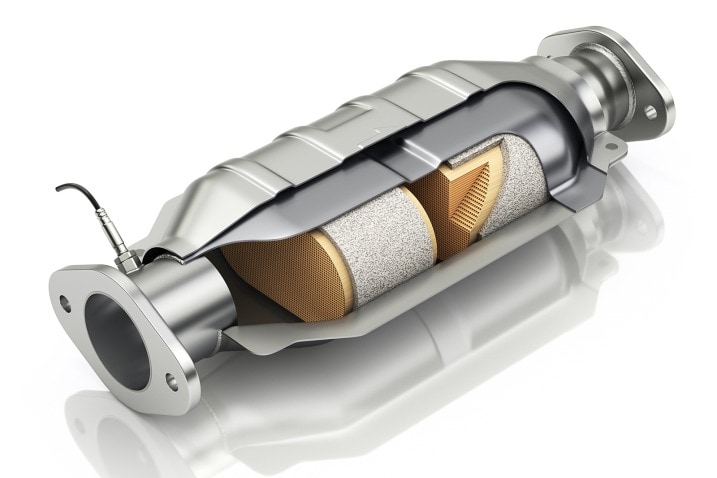1. How does a catalytic converter work?
All gas-powered vehicles produce a number of harmful pollutants as a byproduct of their internal combustion engines. These pollutants include carbon monoxide, nitrogen dioxide, nitrogen oxide and volatile organic compounds. The job of a catalytic converter is to reduce the amount of pollutants and transform them into less toxic gases such as water vapor and carbon dioxide.
Inside the catalytic converter are two ceramic honeycomb pieces: a reduction catalyst and an oxidation catalyst. Both are coated with precious metals. Hot exhaust from the engine enters through one side of the catalytic converter and is exposed to the catalysts. This exposure causes a chemical reaction that breaks down the exhaust's pollutants into less harmful gases. These gases then exit through the other end and out of the vehicle's tailpipe.
Vehicles built from 1981 utilize what is referred to as a three-way catalytic converter. This type of converter has:
An oxidation catalyst: It works double time and uses platinum and palladium to add oxygen and transform carbon monoxide (CO) into the less harmful carbon dioxide (CO2). It also changes any unburned hydrocarbons into carbon dioxide and water (H2O).
A reduction catalyst: It uses platinum and rhodium to reduce nitrogen oxides (NOx). The nitrogen oxide atoms are broken down into nitrogen (N2) and oxygen (O2), which are safer to breathe.
Catalytic converters work in tandem with a vehicle's oxygen sensor(s) and fuel injection system to monitor the air-to-fuel ratio to ensure that there is enough oxygen in the exhaust to allow the oxidation catalyst to efficiently burn carbon monoxide and any unburned hydrocarbons.
How do catalytic converters work on a diesel engine?
Diesel engines run cooler than traditional gas engines, produce more soot and particulate matter, and do not work as well to reduce nitrogen oxide emissions. As a result, their catalytic converters are more complicated. Modern diesel engines use up to three components to reduce emissions: a diesel oxidation catalyst (DOC), a diesel particulate filter (DPF) and a selective catalytic reduction (SCR) catalyst. The SCR uses diesel exhaust fluid to assist with the chemical process to burn off unwanted pollutants. This fluid needs to be replaced around the same time as the oil is changed.
2. Common problems with catalytic converters
Catalytic converters require high temperatures in order to work effectively. This means your vehicle is most likely to pollute the air when the engine is cold and you first start it up. The catalytic converter starts to heat up as the engine's hot exhaust gases flow through it and out of the tailpipe. It is also why experts recommend handling all your errands at the same time rather than making short trips in a vehicle with a cold engine.
Hybrid vehicles have an advantage: Many of them can use their hybrid battery pack to power an electrically heated catalyst. This heater shortens the time it takes for the catalytic converter to heat up to a high temperature, thereby reducing emissions more effectively.
According to the Walker, an exhaust systems company, most catalytic converter failures can be attributed to one of three issues:
Overheated, melted or broken converters: Malfunctions that cause an unusually high level of carbon monoxide or hydrocarbons, and also oxygen, will dramatically increase the temperature and damage the catalytic converter.
Potential causes include engine misfires, low compression, little to no spark from the spark plugs, or a cylinder imbalance. If there's an excessive engine load on the vehicle — caused by worn-out oxygen sensors, excessive backpressure, poor fuel quality or issues with the fuel delivery system — this too can affect the catalytic converter.
Overly coated catalyst: A catalytic converter is considered to be fouled or poisoned when the converter is exposed to substances that coat the working surfaces and saturate the catalyst to the point where it cannot contact and treat the exhaust gases.
Potential causes include excessive carbon buildup in the exhaust, internal coolant leaks, excessive oil burning, and use of improper fuels such as E85 or diesel in a gas-powered car.
Structural damage: It tends to occur when road debris hits the converter and harms it to the point where it no longer functions properly.
Other potential causes include corrosion over time, stress fractures on the metal, stripped oxygen sensor threads, or pipe failures.
Signs that your catalytic converter might have an issue: According to the Universal Technical Institute, if your check engine light comes on, you notice a decrease in fuel economy, have poor acceleration, smell sulfur or rotten eggs, or fail your emissions test, it might be worth checking with your mechanic to see if the catalytic converter needs to be replaced. Finally, if your engine sounds much louder than usual when you start it up, there's a good chance your catalytic converter has been stolen.
3. How long does a catalytic converter last?
In theory, a catalytic converter should last the life of the engine, but in reality, its lifespan will depend on what issues might come up during ownership. If any of the malfunctions we described above have occurred, it won't last that long. An estimate that seems like a safe bet is about eight years since that is the amount of time covered by the federal emissions warranty.
4. Can you drive without a catalytic converter?
Yes, but it's probably not a good idea. The vehicle will likely experience reduced performance and worse fuel economy and have more harmful emissions spewing from the tailpipe. If the catalytic converter is clogged, it could either cause the engine to shut down or, worse, damage the engine.
There are also legal issues to consider, as it is against the law in every state to drive with a bad catalytic converter or without one altogether. There's a chance you could get pulled over or fail your emissions test at the time of registration. Similarly, federal law prohibits replacement of the catalytic converter in favor of a converter replacement pipe or "straight pipe," often used to modify vehicles for performance.
5. Can you fix or replace a catalytic converter yourself?
Yes, but it will depend on your mechanical skill level and whether you have the right tools. Some catalytic converters are bolted on, which are easier to replace, while others must be welded on with a welding machine. If welding is involved, we recommend leaving it to the professionals who have experience and have been properly trained. In either scenario, care is needed to avoid damaging other parts. You'll also need to be careful about the replacement part you buy. For states that have adopted California's emissions standards (CARB), any emissions related parts must be CARB certified or compliant.


 by
by 
